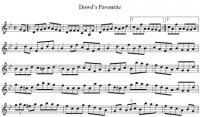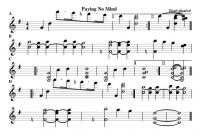-
Posts
229 -
Joined
-
Last visited
Everything posted by Jack Campin
-

Source Of Dark Green Leather?
Jack Campin replied to david robertson's topic in Instrument Construction & Repair
Band name! -

Velum Under Fretwork - Replace Or Renew ?
Jack Campin replied to BILL321's topic in Instrument Construction & Repair
Velum with one L usually means something rather different... as in this image search result... http://t0.gstatic.com/images?q=tbn:ANd9GcRTYiSWAeEBDCNFH8g1j1ODWR_U1x-oAS4GSFPRgxdkoYtPBkYsjKzFAw If I saw that under the fretwork I'd be inclined to leave it alone. -
The Lord Hood, Greenwich, every Tuesday night. Almost entirely English.
-
They are DIFFERENT GENRES. Not only did Mozart use different languages for each, the forms are different and so is the instrumentation. The Italian equivalent of German "lied" is "canto", not "aria". Anyway - can the OP not simply take a photo of a distinctive phrase from the music and upload it? (If the original was a concerto, my bet is that it will turn out to be the famous 6/8 finale from the horn concerto no.4, since that should transfer to the concertina reasonably well).
-
Mozart wrote very few songs, none of them are also concertos, and even his smallest concertos won't fit on two pages. Converse has done a bit of tacky renaming along the lines of "Lovers' Concerto" and "Symphonies for the Sixties". The melodies of Mozart's music are certainly not copyright anywhere. Just scan or photograph the main theme and upload it.
-

Whitby Folk Week Uk 19Th -25Th August 2017
Jack Campin replied to AnnC's topic in Public News & Announcements
Probably won't be back - we've had affordable accommodation for the last few years but we can't get anything comparable now. -

Looking For Music For The 34 Hayden Duet?
Jack Campin replied to Button Pusher's topic in Tunes /Songs
Not too sure of the capabilities of that thing, but maybe 18th century Scottish music might fit - as published (by the Gows among others) the arrangement usually fitted a violin in first position and a cello played in a very simple agricultural vamping style. So - left hand down to C below the bass staff up to the D above it, right hand from G below the treble staff up to B above it.- 20 replies
-
- Hayen Duet
- sea shanties
-
(and 1 more)
Tagged with:
-
Are there any recordings of Roger Quin, the tramp/busker poet/fluteplayer/concertinist of the Scottish Borders (1850-1925)? I've got a first edition copy (at work, it's for sale) of his book of poems "The Borderland" - he was good.
-

Music For A Found Harmonium - For G/d Anglo
Jack Campin replied to Will Moore's topic in Concertina Videos & Music
I have a brutally compressed single-line version, fitting easily on one A4 page, in the Nine Note Tune Book on my website: http://www.campin.me.uk/ I've eliminated all repeated notation and used the ABC part construct to tell you what order to reassemble the bits in. The result is that there is much less to read or remember and you can better predict where the tricky bits are going to come. -
Maybe booking a few private lessons might be more effective?
-
Is that the same Jones as the company that made the godawful sewing machines?
-
Try https://www.flutetunes.com - simplified classical music is their main thing.
-
Why not simply attach the file to the post? It gets stored along with the forum postings rather than on Dropbox, surely? I've done that here with David's transcription. On my (very old) machine, YouTube videos are sometimes shifted in pitch from how the uploader intended - maybe that happened this time.
-
A dorian/minor hexatonic, I think (there may be an F sharp in there but I didn't notice one on a single hearing).
-

Using 'p' (Parts) In Abc Code...or Not
Jack Campin replied to bellowbelle's topic in Teaching and Learning
-
That handwritten version of "Latt om Foten" was in 3/4. 6/8 would be completely wrong, there are three beats to the bar. (If it isn't a mazurka, what else could it be? - the dancers in the Girona video are mazurkitating to it). Changes between 2/something and 4/something are often to make the tempo sensible. Reels and strathspeys both have about 100 beats per minute. That usually means notating reels in 2 and strathspeys in 4. A metronome speed of twice that would be too many ticks to take in.
-

Using 'p' (Parts) In Abc Code...or Not
Jack Campin replied to bellowbelle's topic in Teaching and Learning
It is sometimes a problem when the logical "part" is ridiculously small, but there's often a way round it. Can we see your example? The "segno" stuff in ABC is rubbish (a notation for generating notation, not a notation for music). -
I'm thinking of what happens when you think a tune up. Twice when I've done it, I ended up in standard types of hexatonic scale - dorian/minor for one, mixolydian/dorian for the other. I only realized that after writing them down. It happened because I was using kinds of melodic formula that result in those modes; I never had any conscious intention of leaving a gap in the scale. As I said, it's useful for a performer or arranger to know the mode after the tune has come into existence, but in my experience you don't think of it when composing one.
-
I'm not sure if I changed anything in that one, but I usually notate mazurkas as 9/8, since that seems to be a commoner way to play them, even when they aren't written that way. As Geoff says, you need to find out what the dancers prefer. It's easy enough to switch between swung and straight.
-
There is an intriguing dichotomy which may relate to what you're saying there. Modes as applied to folk music are generally descriptive - people who create the music do so by following implicit rules which they can only partly describe, if at all. It's very useful for a performer or arranger to know what modes the composer used, but that comes later. On the other hand, in art music traditions like the improvised music of the Middle East, the mode comes first - a player always knows exactly what mode they're playing in and why and what mode they're going to modulate into. The tonal structures may be exactly the same in both cases but the background psychology could not be more different.
-
Catherine Bott is credited with writing that. In her day job she is a very, very good singer and should know better. I suspect she was drunk as a skunk at the time and put it together on her phone in a pub when a subeditor called in a hurry. I am increasingly going exactly against that. There are analytical techniques currently used for some genres which give a lot of insight into others where they haven't been used before. And it's enlightening to see how the music you know unexpectedly resembles stuff you don't know, when you look at it right. (It is also illuminating to know when you've gone over some kind of technical chasm into a genuinely different way of stringing sounds together; you know you need to listen in a new way). I zero in on Scottish music (a) because I know it and ( because it contains illustrations of a heck of a lot of different musical procedures, enough to batter any glib national generalizations into the ground. The same framework will work much more widely. (Just now typing in a Hungarian song which is identical modally to a lot of Scottish ones, and with the same phrasing, but uses rhythms you'd never hear west of Vienna).
-
I have a tutorial on modes on my website: http://www.campin.me.uk/Music/Modes/ which I have been rewriting for a few months - it's already the largest document on the subject on the web and the new one will be about 4 times as big. The quoted passage is historically rubbish and about as totally, uselessly meaningless and ignorant as it is possible to get.
-

Different Learning Process For Musicians?
Jack Campin replied to Teriodin's topic in Teaching and Learning
I have a couple of very good tutor books (for other instruments) where what looks a bunch of absolutely trivial stuff on the first few pages turns out to be nothing of the sort when you actually try to play it. So maybe don't skip too fast?




